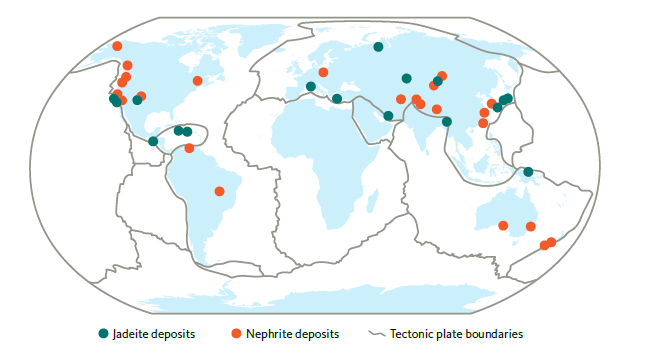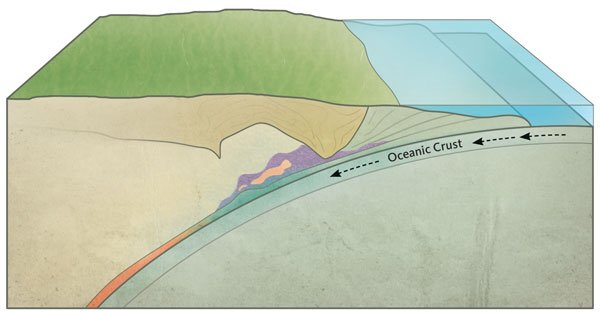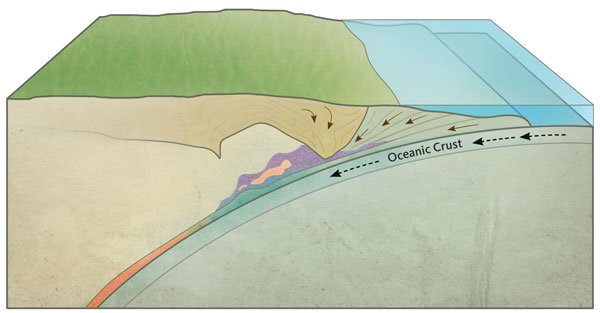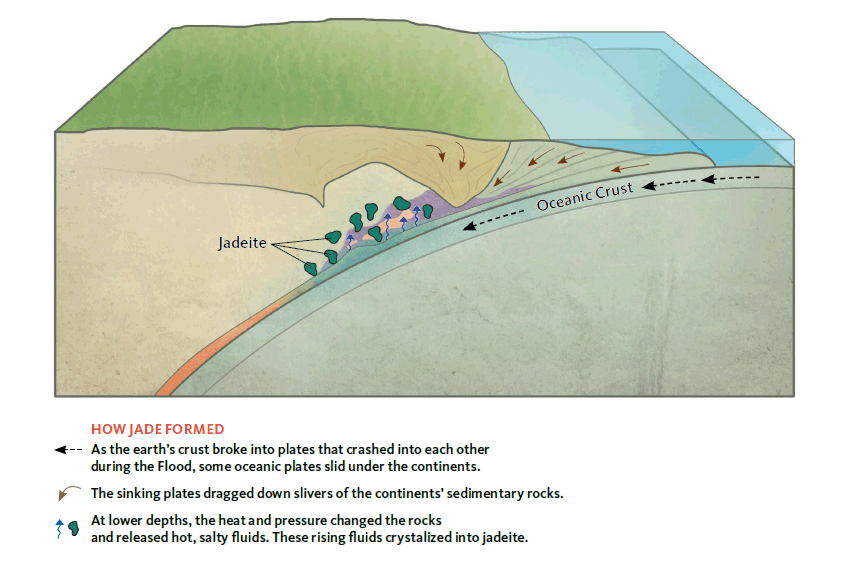Jade—Beauty Under Pressure
Forming the coveted qualities of jade requires unique conditions unlike anything on earth today.
Walk into the Chinese collection at any art museum and you’ll see beautiful jade carvings—pale green dragons, yellow pendants, translucent white flowers, pink vases, and vivid green tableware used by emperors.
Even before it was prized for beauty, this precious stone had another attraction. It is tough, yet easy to shape. So ancient people often carved it into axes, blades, choppers, and hammers. But today its beauty is paramount.
The biblical Flood cataclysm provided just the right kind of rare, stressful conditions necessary to produce the beautiful gemstone jade.
Treasured since ancient times, jade was the stone of choice in the imperial court of China. Royal families made burial suits out of jade by joining square pieces into full-body garments. Today jade is still prized in China, where it commands as much as $3,000 per ounce (28.4 grams), depending on color and rarity.
Jade was popular not only in ancient Chinese, Japanese, Korean, and other East Asian cultures, but also in the Americas. In Central America, Aztec Indians wore it as a talisman, thinking it had special powers to ease abdominal pain.
So where did jade come from? Astonishingly, the biblical Flood cataclysm provided just the right kind of rare, stressful conditions necessary to produce this beautiful gemstone.
What Is Jade?
The name jade actually applies to two rocks made up of different minerals with different hardnesses.
The hard green jade that was prized in ancient times comes from a mineral called jadeite.1 Pure jadeite is white, and when it’s transparent or translucent, it’s sometimes called “water jade.” Impurities from the metal chromium produce the vivid emerald-green of “imperial jade.” Other colors of jadeite include leaf-green, mauve, and intense blue, depending on the metal impurities (iron, manganese, or titanium respectively).
The softer jade is from a rock composed of nephrite.2 The translucent white to very light yellow variety, known in China as “mutton fat jade,” is almost pure tremolite (one of the two main ingredients in nephrite, tremolite is rich in magnesium). It is highly prized today. The green “spinach jade” is the most recognized variety of nephrite, though its color varies from near black to gray-green. When this softer jade is nearly emerald green, it is still prized today for carvings and jewelry.
Widespread Beds of Beauty
The largest and most important deposits of jadeite are in northern Myanmar (Burma) and Guatemala (see map).3 The most important deposits of nephrite are in northern British Columbia, Canada; in Xinjiang, China; near Lake Baikal in Siberia, Russia; and near Cowell, South Australia. Other deposits are small or have been exhausted. The locations of these jade deposits, particularly of jadeite, help us understand how they formed, especially as we look at their relationship to the earth’s tectonic plates.

Gems in the Circle of Fire
Jade deposits are typically found at the boundaries of the earth’s
tectonic plates. Jade comes from two types of rock. Jadeite yields
harder jade, such the famous green imperial jade (main deposits
in Southeast Asia and Guatemala.) Nephrite yields softer jade
(main deposits in Canada, China, and Australia).
Plate tectonics is the study of the structure of the earth’s crust and mantle, with an emphasis on the theory that the earth’s lithosphere has broken up into large plates that are floating very slowly relative to one another on the molten rock beneath them, and interact with each other.4 These plates include both continental and ocean-floor crust (see map).
At their boundaries the plates interact in three ways, depending on the directions they are moving:
- Plates slide past one another along major fault zones.
- Ocean-floor crust is pulled apart as new ocean floor material rises where plates are moving apart.
- Plates collide, and one either subducts (goes under the edge of the other plate) or rides up over the edge of the other plate to produce a mountain range.
Look at the locations of jadeite and nephrite deposits on the world map with the crustal plate boundaries superimposed on it. Notice that most of the jadeite deposits and many of the nephrite deposits coincide with current subduction zones or former collision zones.
Laboratory experiments show us that jadeite forms at temperatures of 480–1110°F (250–600°C) under the extreme pressures of 87,000–507,500 pounds per square inch (0.6–3.5 GPa).5 These conditions occur at depths of 12.5–75 miles (20–120 km) below the earth’s surface, so the jadeite must have formed in subduction zones where plates collided.
The hard jadeite formed in these collision zones as oceanic crust plates slid beneath the edges of moving continental plates. As the oceanic crust was subducted, it also dragged down slivers of continental sedimentary rocks (see diagram). Along the collision zone, the heat and high pressures metamorphosed (changed the form and nature of) those oceanic rocks and sedimentary rocks and released very hot, salty fluids. These fluids crystalized into jadeite, which is usually found near beds of serpentinite (the oceanic crust that was transformed).
How Jade Formed
Nephrite deposits tell a similar story. They form at temperatures of 210–840°F (100–450°C) and pressures of 14,500–72,500 pounds per square inch (100–500 MPa), also in the presence of watery fluids.6
Unlike jadeite, the softer nephrite deposits form in two different geologic settings. Many nephrite deposits have formed in plate collision zones (see map). However, these deposits are usually located where slabs of oceanic crust broke off and shoved up (obducted) into the sedimentary rocks on the continental edges. These sedimentary rocks were being crumpled in the collision zones, generating intense heat and pressure that metamorphosed them, producing serpentinite. The fluids generated by these processes became trapped within the serpentinite and transformed portions into nephrite.
The other geologic setting in which nephrite forms is very different. Among ancient sedimentary rock layers is a type of limestone called dolomite.
Dolomite layers that were metamorphosed by heat and pressure were transformed into dolomitic marble. Often molten granites intruded into these metamorphosed rocks. As the molten granites crystallized, hot fluids were released and penetrated the dolomitic marble layers, transforming portions into nephrite deposits.
The Ultimate Pressure
What would cause the plates to move to such an intense, dramatic degree that the pressure caused jade deposits to form?
We who believe the Genesis account
don’t have to look very far for answers!
Genesis 1:9 seems to imply that most
of the land God made on Day Three of
the Creation Week was probably one
supercontinent.7 Then when the Flood
began, Genesis 7:11 says, “All the fountains
of the great deep were broken up.
”
The rare beauty of jade was produced by rocks that had to undergo transformation by heat, extreme stresses, and water.
This catastrophic bursting forth of hot waters and upwelling molten rock would have caused massive rifts in the seafloor (“the great deep”). Such rifting would have rapidly spread around the globe—including across the supercontinent, tearing the earth’s crust apart into oceanic crust and continental plates.
The plates, in turn, moved and collided, causing the heat, extreme pressures, and hot saline fluids that produced jadeite and nephrite deposits.
Remember the Flood waters also swept over the continental plates, depositing huge piles of fossil-bearing sediments rapidly across the continents. In some places the deep burial of these sediment piles and accompanying earth movements metamorphosed those sediments. Molten granites also intruded into them. Hot watery fluids penetrated the dolomitic marble layers and transformed many into nephrite deposits.
So today’s jade deposits formed out of a catastrophe, the global Flood cataclysm. The vivid colors of rare jade beauty were birthed by heat, extreme stresses, and watery fluids. Jade has value for us not only as a precious stone, but also because it is a beautiful reminder of one of the most tragic events in biblical history—the worldwide Flood.
The way jade is formed also holds a devotional lesson for us. How many times in our lives do we groan and shed tears under the pressures of trials and afflictions?
The Apostle Paul knew about the
stresses of feeling our world is in violent
upheaval. Under the direction
of the Holy Spirit he penned these
words: “We are hard-pressed on every
side, yet not crushed . . . . For our light
affliction, which is but for a moment,
is working for us a far more exceeding
and eternal weight of glory
” (2 Corinthians 4:8, 17).
The rare beauty of jade, which was produced by rocks that had to undergo transformation by heat, extreme stresses, and water, should remind us that our Heavenly Father allows our trials and afflictions to conform us into the image of His Son, our Creator and Redeemer Jesus Christ. In this way He brings out His beauty in our lives—and that is ultimately more precious than all the jade in the world!
Answers Magazine
October–December 2016
Your irresistible urge to snatch up that cute little puppy and hug it for all youʼre worth isnʼt just a feeling. Itʼs science.
Browse Issue SubscribeFootnotes
- A variety of the pyroxene group of single chain silicate minerals with the chemical formula NaAlSi2O6 and a Mohs scale hardness of 6.5–7.0. See A.A. Snelling, “Shape-Shifting Silicon,” Answers 9.4 (October–December 2014): 52–55.
- A variety of the amphibole group of double chain silicate minerals with the chemical formula Ca(Mg,Fe)5Si8O22(OH)2 and a Mohs scale hardness of 6.0–6.5. See A.A. Snelling, “Shape-Shifting Silicon,” Answers 9.4 (October–December 2014): 52–55.
- G.E. Harlow, S.S. Sorenson, and V.B. Sisson, “Jade,” in Geology of Gem Deposits (Short Course Series Volume 37), ed. L.A. Groat (Quebec: Mineralogical Association of Canada, 2007), 207–253.
- A.A. Snelling, “Plate Tectonics—The Reality Behind a Theory,” Answers 11.1 (January–March 2016): 52–55.
- R.J. Stern, T. Tsujimori, G.E. Harlow, and L.A. Groat, “Plate Tectonic Gemstones,” Geology 41.7 (July 2013): 723–726.
- Ref. 3.
- A.A. Snelling, “A Catastrophic Breakup—A Scientific Look at Catastrophic Plate Tectonics,” Answers 2.2 (April–June 2007): 44–48.
Recommended Resources

Answers in Genesis is an apologetics ministry, dedicated to helping Christians defend their faith and proclaim the good news of Jesus Christ.
- Customer Service 800.778.3390
- © 2024 Answers in Genesis









